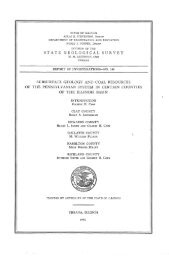2008 ISGS Annual Report - University of Illinois at Urbana-Champaign
2008 ISGS Annual Report - University of Illinois at Urbana-Champaign
2008 ISGS Annual Report - University of Illinois at Urbana-Champaign
You also want an ePaper? Increase the reach of your titles
YUMPU automatically turns print PDFs into web optimized ePapers that Google loves.
Wetlands and Environmental Assessments<br />
Tollway Run<strong>of</strong>f Monitoring<br />
Project Begins<br />
Wetland scientists <strong>at</strong> the<br />
<strong>Illinois</strong> St<strong>at</strong>e Geological<br />
Survey began a 3-year<br />
project monitoring w<strong>at</strong>er<br />
quality for the <strong>Illinois</strong> St<strong>at</strong>e<br />
Toll Highway Authority.<br />
The project goal is to<br />
determine the effectiveness<br />
<strong>of</strong> bioswales th<strong>at</strong> are now<br />
under construction along<br />
a section <strong>of</strong> I-294, which is<br />
being widened.<br />
Bioswales, or veget<strong>at</strong>ed<br />
wetland drainageways, are<br />
intended to lessen the impact<br />
<strong>of</strong> contaminants from<br />
tollway run<strong>of</strong>f on groundw<strong>at</strong>er<br />
quality. The bioswales<br />
are intended to increase<br />
run<strong>of</strong>f contact time with<br />
Charles Knight, <strong>ISGS</strong> scientist in the Wetlands<br />
Section, collects discharge d<strong>at</strong>a from a<br />
roadside ditch <strong>at</strong> the future site <strong>of</strong> a bioswale<br />
along I-294 in Des Plaines, <strong>Illinois</strong>.<br />
wetland veget<strong>at</strong>ion and soils, which transform nutrients and remove<br />
suspended sediment and certain other pollutants.<br />
The first phase <strong>of</strong> this project involves the emplacement <strong>of</strong> autom<strong>at</strong>ed<br />
samplers, flow meters, and w<strong>at</strong>er-quality d<strong>at</strong>a loggers <strong>at</strong> three st<strong>at</strong>ions<br />
along the tollway. The inform<strong>at</strong>ion provided by these instruments<br />
will help the scientists to monitor run<strong>of</strong>f prior to construction <strong>of</strong> the<br />
bioswales and to establish the baseline loads <strong>of</strong> target contaminants<br />
leaving the roadway onto adjacent lands owned by the Forest<br />
Preserve District <strong>of</strong> Cook County or directly into the Des Plaines<br />
River. L<strong>at</strong>er phases will measure the effectiveness <strong>of</strong> the bioswales<br />
after construction and compare the quality <strong>of</strong> run<strong>of</strong>f discharged by the<br />
bioswales to the present load.<br />
Preliminary Site Assessments<br />
The Environmental Site Assessments Section <strong>of</strong> the <strong>ISGS</strong> conducts<br />
preliminary environmental site assessments for the <strong>Illinois</strong> Department<br />
<strong>of</strong> Transport<strong>at</strong>ion (IDOT). These assessments are designed to<br />
provide IDOT with environmental inform<strong>at</strong>ion early in project planning<br />
stages, so th<strong>at</strong> St<strong>at</strong>e infrastructure projects can be completed on<br />
time and on budget. Site assessments are conducted in all nine IDOT<br />
districts and can range in scope from work <strong>at</strong> intersections to major<br />
bridge and highway projects. Potential hazards identified by <strong>ISGS</strong><br />
work can then be avoided, remedi<strong>at</strong>ed, or mitig<strong>at</strong>ed, depending on<br />
IDOT project needs. During the period covered by this annual report,<br />
the section completed 107 site assessments for IDOT.<br />
Interst<strong>at</strong>e 355 Extension Opens<br />
<strong>Illinois</strong> St<strong>at</strong>e Geological Survey staff members played a large role<br />
in the environmental studies for the I-355 tollway south extension<br />
from I-55 to I-80, which opened on November 11, 2007. Beginning in<br />
1989, various proposed alignments were evalu<strong>at</strong>ed for their potential<br />
23<br />
Site assessment equipment during the environmental<br />
studies along the I-355 extension route<br />
from I-55 to I-20.<br />
for hazardous waste,<br />
and the results <strong>of</strong> those<br />
studies were used in<br />
alignment selection.<br />
The studies continued<br />
through 2002, when<br />
specific parcels to be acquired<br />
were assessed for<br />
potential environmental<br />
hazards in a cooper<strong>at</strong>ive<br />
agreement between the<br />
<strong>Illinois</strong> Department <strong>of</strong><br />
Transport<strong>at</strong>ion and the<br />
<strong>Illinois</strong> St<strong>at</strong>e Toll Highway<br />
Authority.<br />
Significant delays in construction<br />
were caused<br />
by the presence <strong>of</strong> the<br />
Hines emerald dragonfly,<br />
a federally endangered<br />
insect th<strong>at</strong> inhabits seeps along the tollway route in the lower Des<br />
Plaines River valley. Scientists <strong>at</strong> the <strong>ISGS</strong> were involved in several<br />
phases <strong>of</strong> habit<strong>at</strong> planning for the tollway. Involvement began in the<br />
early 1990s with a study on the impacts on dragonfly habit<strong>at</strong> from the<br />
potential reduction <strong>of</strong> seep discharge caused by the loss <strong>of</strong> infiltr<strong>at</strong>ion<br />
from new impermeable roadway surfaces. Routing and design alter<strong>at</strong>ions<br />
were suggested <strong>at</strong> th<strong>at</strong> time. The <strong>ISGS</strong> is currently working to<br />
help mitig<strong>at</strong>e the tollway’s impacts on the dragonflies by studying the<br />
hydrology and geochemistry <strong>of</strong> the current dragonfly habit<strong>at</strong>s to help<br />
design new dragonfly habit<strong>at</strong> restor<strong>at</strong>ion areas.<br />
<strong>ISGS</strong> Provides Environmental<br />
Work for Mississippi River Bridge<br />
On Monday, December 17, 2007, the McKinley Bridge, which connects<br />
Venice, <strong>Illinois</strong>, to St. Louis, Missouri, reopened to traffic. Built<br />
in 1910 for rail lines, the<br />
bridge was closed in 2001<br />
for major reconstruction.<br />
<strong>ISGS</strong> Environmental<br />
Site Assessments staff<br />
conducted environmental<br />
studies for the <strong>Illinois</strong> Department<br />
<strong>of</strong> Transport<strong>at</strong>ion<br />
prior to the rehabilit<strong>at</strong>ion<br />
<strong>of</strong> the bridge, which<br />
included evalu<strong>at</strong>ion <strong>of</strong><br />
potential excav<strong>at</strong>ion sites<br />
for the presence <strong>of</strong> hazardous<br />
waste. Formerly a<br />
toll bridge, the bridge has<br />
reopened as a toll-free<br />
bridge and now has lanes<br />
devoted to bicycle and<br />
pedestrian traffic.<br />
McKinley Bridge connecting Venice, <strong>Illinois</strong>, to<br />
St. Louis, Missouri.

















